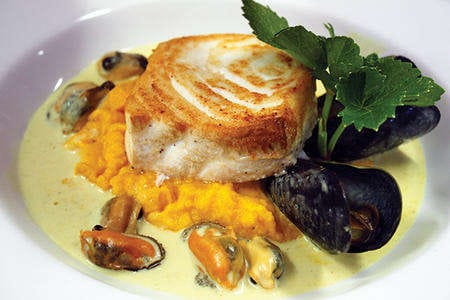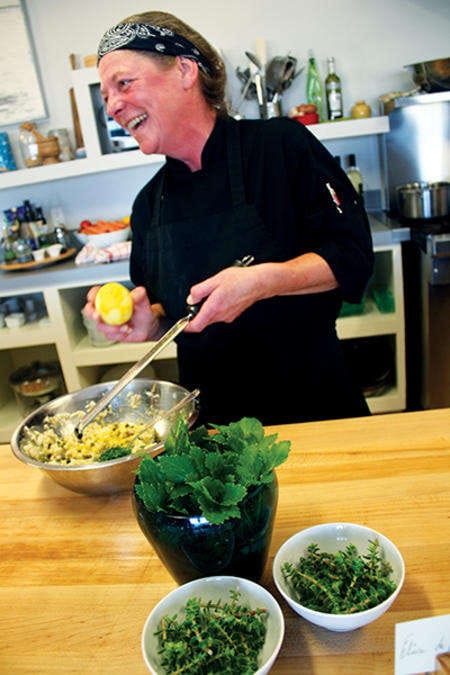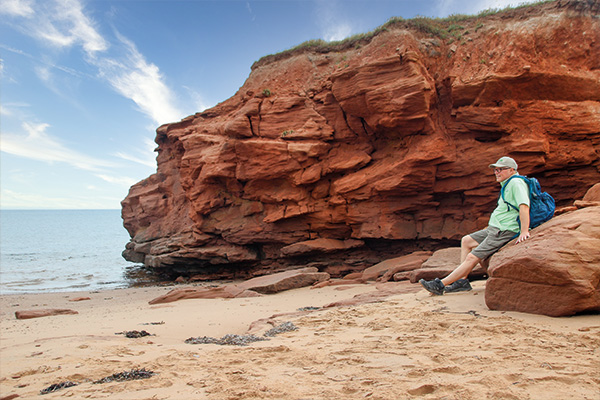The flavours of Îlse de la Madeleine
“If food were a textbook, the subject would be history. I’m here on Îles de la Madeleine , a Quebec archipelago of seven islands between PEI and Newfoundland, six of which are strung together by miles of sand beach into the shape of a fishhook, for a cooking class. The location is Gourmande de Nature on Cap-aux-Meules , the main island. The class is Homage à Ma Mer, which translates as a double entendre meaning a tribute to both sea and mother. For owner, cook and instructor Johanne Vigneau, the French words mer and mère seem interchangeable as if she were raised and taught equally by each.
Johanne is a daring cook and generous with her skills. She learned them from her mother who prepared meals for her 11 children at a time when local foods were the only foods and the sea was still a bottomless larder and the 300 kilometres of beaches stained a reddish hue as if by an all day sunset yielded herbs and spices to those attentive enough and persistent.
To demonstrate what’s possible, assistant Denis Lemoine taps wild caraway seeds from a dried stem onto the counter and snaps open poivre des dunes or alder catkins he picked green last February. They’re surprisingly spicy, like bitter peppercorns with a hint of citrus. He crushes wild bay between his fingers and passes bowls of translucent rose petals, stems of succulent seaside sandplant and freshly picked sea parsley that looks like the Italian flat-leafed variety.


The first course is salt cod bruschetta on slices of baguette from the local boulangerie, browned quickly in hot olive oil and smeared with tapenade. Johanne’s mother cured fish on the clothesline and mixed her salt cod with shortening, but Johanne douses the chopped fish in olive oil. “No measuring today,” she says. “The best assistant in the kitchen are the fingers,” she adds as she squeezes lemon juice with a clenched fist. She piles the mixture onto baguette slices topped with baby arugula and roasted tomato with that sea parsley as garnish. A series of satisfying crunches resounds around the room as each of us bite into this island appetizer.
For our next lesson, Johanne fastens two sheets of parchment paper to the countertop with dots of sticky reduced balsamic, then streaks the sheets with the sweet vinegar. Here, she invites the dozen participants to help her build two distinctive salads that share a single ingredient—moonsnail that we’ve learned to clean, chop and sauté. When finished, we crowd around to take photos and scoop up saucers full. I tuck into seconds of the Japanese inspired mesclun mix of delicate seaweeds with radish slices, crushed wasabi peas and sesame.
“It’s all from your head,” says Johannes of the recipe in Acadian French as close to the language spoken 500 years ago in France as it is in Quebec today. Of the 13,000 Madelinot, 95 per cent are francophone. This is Quebec, but it feels equal parts western European satellite and eastern Maritime fishing outport. It is said that the people of each island in the archipelago speaks in an accent particular to their scrap of land out here in the Gulf of St. Lawrence. But like the cod, herring and halibut that once sustained them, their accents are disappearing.
Now a rare delicacy, halibut is the main dish. Lucky us because these steaks are carved from a fish caught locally during the recent season that lasts just seven hours annually. Johanne guides us through a preparation passed down more than two centuries. Her father was a fisherman who regularly brought home fish for supper. The thick steaks are quickly seared to seal in flavour and moisture then finished in a warm oven. Plated on an island of pureed buttery carrots in a creamy moat of curried mussel sauce, the meal reminds me that on Îles de la Madeleine, the sea is in the people as much as it’s in the food.
Family traditions
This is the way it is across the archipelago. A marine crossroads, this is where fishermen stationed their operations for 500 years to harvest a once teeming ocean. When herring stocks collapsed in the 1970s, a single smokehouse on Havre-aux-Maisons belonging to the Arseneau family was spared out of pure sentiment. Thirty years later, when a few herring returned to these waters, three Arseneau brothers motivated by little more than nostalgia reopened their father’s smokehouse as Le Fumoir d’Antan.
After thanking Joanne at Gourmande de Nature for teaching me how to read history through Madelinot foods, I head to Le Fumoir for a tour with Felix Arseneau, a grandson of the founder. The museum shows an industry that once processed a million pounds a year and employed 1,200 people. Today, Felix’s family cures a respectable 80,000 pounds a year inside the steep-roofed barn next door where fires smolder and herring cure on canes in the eaves for three months.
From burly fisherman stock, big Benoit Arseneau offers me a sample of the dark herring “loin.” It’s rich and firm with a warm smokiness. Benoit explains he reopened the smokehouse because his father told him they couldn’t lose this family tradition. Far from losing it, as ever-adaptable Madelinot, the Arseneaus are learning how to make it thrive. Benoit says to follow him from the store full of tourists out back to see his shiny new mechanical smoker where he cures salmon, eel, sturgeon and locally farmed scallops.
If food were history, here it would be the taste of a once abundant ocean. Abundance these days is found in what remains and what can be grown. The scallops in the Arseneaus’ smokehouse are grown just beyond the hill in the vast northern lagoon where shellfish farms flourish in the warm, sheltered waters. I’m treated to a special trip with former oceanographer Melanie Bourgeois of Culti-Mer to help harvest this newly farmed species. Strings of netted baskets filled with oysters, mussels and scallops are hauled aboard. “Chefs say these are sweeter than wild ones,” says Melanie, handing me a freshly shucked scallop on a half shell, which she explains lead a sedentary life in these baskets. I slurp it down, and agree—the meat is sweet, tender and briny. About the only remaining obstacle to the success of Culti-Mer’s experiment with scallops is seal predation.
I’ve heard that seals and seal meat are common here. At the very busy butcher shop Côte à Côte , Réjean Vigneau proudly holds up a heaping pan of his seal sausages made from animals he hunted himself. Customers grab other in-house seal products like paté, pepperoni and terrine from the coolers. Curious, I hit the road in search of seal on local menus. At Pizza d’ la Pointe , I discover a pie with confit of seal, bacon, mandarin orange and local raw milk cheese. The juicy orange slices balance the richness of the other ingredients. At Pas Perdus , a contemporary restaurant around the corner from the butcher shop, I order a seal burger before boarding the evening ferry back to PEI. The dense, smooth meat is mixed with pork to cut the richness and the gaminess so it’s sweet, juicy and so filling, the flavour alone is what pushes me to finish every last bite.
Aboard the ferry and sated, I look back at the green hills of the archipelago edged with red cliffs that reach to the horizon on beaches tinted an even deeper red by the sunset. The view from the upper deck makes a postcard of the place I’ve come to know through a cuisine particular to these waters, these scraps of land, the Madelinot people and their history.



